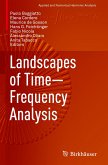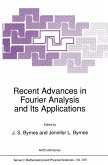A sweeping exploration of the development and far-reaching applications of harmonic analysis such as signal processing, digital music, Fourier optics, radio astronomy, crystallography, medical imaging, spectroscopy, and more. Featuring a wealth of illustrations, examples, and material not found in other harmonic analysis books, this unique monograph skillfully blends together historical narrative with scientific exposition to create a comprehensive yet accessible work. While only an understanding of calculus is required to appreciate it, there are more technical sections that will charm even specialists in harmonic analysis. From undergraduates to professional scientists, engineers, and mathematicians, there is something for everyone here.
The second edition of The Evolution of Applied Harmonic Analysis contains a new chapter on atmospheric physics and climate change, making it more relevant for today's audience.
Praise for the first edition:
"...can be thoroughly recommended to any reader who is curious about the physical world and the intellectual underpinnings that have lead to our expanding understanding of our physical environment and to our halting steps to control it. Everyone who uses instruments that are based on harmonic analysis will benefit from the clear verbal descriptions that are supplied."
- R.N. Bracewell, Stanford University
"The book under review is a unique and splendid telling of the triumphs of the fast Fourier transform. I can recommend it unconditionally... Elena Prestini... has taken one major mathematical idea, that of Fourier analysis, and chased down and described a half dozen varied areas in which Fourier analysis and the FFT are now in place. Her book is much to be applauded."
- Society for Industrial and Applied Mathematics
"This is not simply a book about mathematics, or even the history of mathematics; it is a story about how the discipline has been applied (to borrow Fourier's expression) to 'the public good and the explanation of natural phenomena.' ... This book constitutes a significant addition to the library of popular mathematical works, and a valuable resource for students of mathematics."
- Mathematical Association of America Reviews
The second edition of The Evolution of Applied Harmonic Analysis contains a new chapter on atmospheric physics and climate change, making it more relevant for today's audience.
Praise for the first edition:
"...can be thoroughly recommended to any reader who is curious about the physical world and the intellectual underpinnings that have lead to our expanding understanding of our physical environment and to our halting steps to control it. Everyone who uses instruments that are based on harmonic analysis will benefit from the clear verbal descriptions that are supplied."
- R.N. Bracewell, Stanford University
"The book under review is a unique and splendid telling of the triumphs of the fast Fourier transform. I can recommend it unconditionally... Elena Prestini... has taken one major mathematical idea, that of Fourier analysis, and chased down and described a half dozen varied areas in which Fourier analysis and the FFT are now in place. Her book is much to be applauded."
- Society for Industrial and Applied Mathematics
"This is not simply a book about mathematics, or even the history of mathematics; it is a story about how the discipline has been applied (to borrow Fourier's expression) to 'the public good and the explanation of natural phenomena.' ... This book constitutes a significant addition to the library of popular mathematical works, and a valuable resource for students of mathematics."
- Mathematical Association of America Reviews
The goal of this text is to introduce readers to the topic of harmonic analysis, its history, and its applications. Throughout the book, these three major concerns...are artfully intertwined to form a single, unified narrative. This is not simply a book about mathematics, or even the history of mathematics; it is a story about how the discipline has been applied (to borrow Fourier's expression) to 'the public good and the explanation of natural phenomena.'...[T]he author considers a remarkably broad collection of applications, from space exploration to classical music to CAT scans. The treatment of each topic is thorough and comprehensive, paying equal attention to mathematics, application, and historical context.
...It is evident that a great deal of effort has been spent in the preparation of this book. The author has diligently worked to create a cogent, sensibly organized exposition. The text is supplemented with dozens of interesting pictures and graphs....[T]his book constitutes a significant addition to the library of popular mathematical works, and a valuable resource for students of mathematics. -MAA Reviews"Prestini...traces the development of harmonic analysis from its origins to applications of the present. She begins with a biography of Fourier and a brief description of the mathematics behind Fourier series, then turns to an overview of the many areas of science that have benefited from Fourier's results. The last seven chapters could be seen as a brief history of technology as Prestini takes readers from the early days of telegraphy, radio, and the telephone, through human understanding of sound and optics to more modern technologies such as X-ray crystallography, MRI, and radio astronomy-all filtered through the lens of harmonic analysis. A good read for anyone interested in applied mathematics.... Highly recommended. Upper-division undergraduates through faculty." - CHOICE"...can be thoroughly recommended to any reader who is curious about the physical world and the intellectual underpinnings that have lead to our expanding understanding of our physical environment and to our halting steps to control it. Everyone who uses instruments that are based on harmonic analysis will benefit from the clear verbal descriptions that are supplied." -From the foreword by R.N. Bracewell, Stanford University"For a little more than fifty years abstract modern harmonic analysis has evolved in ways independent of physical applications. It has become intertwined with abstract group theory and a host of modern analytical techniques. The broader subject has a much longer history, however, as a branch of applied mathematics, which dates back to the active period of the eighteenth century. The present book is concerned with this longer history as an applied science.
In each of the application areas the author provides a sketch of the underlying mathematical tools borrowed from harmonic analysis. The first area is that of historical origins which dealt with waves and heat diffusion.... The author [also] discusses the topics of the fast Fourier transform, signal sampling, quantization, and filtering that are mainstays of modern digital communications as applied to telecommunications and astrophysics. The topics of sound and light provide graphic demonstrations of the role of the spectrum and higher-dimensional filtering.
Perhaps the most important of all applications are the recent ones to medical technology. One example is provided by computerized axial tomography (CAT scans), which are two-dimensional images (density distributions) resulting from measuring the attenuation of x-rays along different paths and rotational angles perpendicular to the vertical axis of the human body. Building these images as well as combining them to obtain three- dimensional reconstructions requires harmonic analytical transform techniques." -Zentralblatt MATH"Elena Prestini's book is not only historically interesting but is also useful
...It is evident that a great deal of effort has been spent in the preparation of this book. The author has diligently worked to create a cogent, sensibly organized exposition. The text is supplemented with dozens of interesting pictures and graphs....[T]his book constitutes a significant addition to the library of popular mathematical works, and a valuable resource for students of mathematics. -MAA Reviews"Prestini...traces the development of harmonic analysis from its origins to applications of the present. She begins with a biography of Fourier and a brief description of the mathematics behind Fourier series, then turns to an overview of the many areas of science that have benefited from Fourier's results. The last seven chapters could be seen as a brief history of technology as Prestini takes readers from the early days of telegraphy, radio, and the telephone, through human understanding of sound and optics to more modern technologies such as X-ray crystallography, MRI, and radio astronomy-all filtered through the lens of harmonic analysis. A good read for anyone interested in applied mathematics.... Highly recommended. Upper-division undergraduates through faculty." - CHOICE"...can be thoroughly recommended to any reader who is curious about the physical world and the intellectual underpinnings that have lead to our expanding understanding of our physical environment and to our halting steps to control it. Everyone who uses instruments that are based on harmonic analysis will benefit from the clear verbal descriptions that are supplied." -From the foreword by R.N. Bracewell, Stanford University"For a little more than fifty years abstract modern harmonic analysis has evolved in ways independent of physical applications. It has become intertwined with abstract group theory and a host of modern analytical techniques. The broader subject has a much longer history, however, as a branch of applied mathematics, which dates back to the active period of the eighteenth century. The present book is concerned with this longer history as an applied science.
In each of the application areas the author provides a sketch of the underlying mathematical tools borrowed from harmonic analysis. The first area is that of historical origins which dealt with waves and heat diffusion.... The author [also] discusses the topics of the fast Fourier transform, signal sampling, quantization, and filtering that are mainstays of modern digital communications as applied to telecommunications and astrophysics. The topics of sound and light provide graphic demonstrations of the role of the spectrum and higher-dimensional filtering.
Perhaps the most important of all applications are the recent ones to medical technology. One example is provided by computerized axial tomography (CAT scans), which are two-dimensional images (density distributions) resulting from measuring the attenuation of x-rays along different paths and rotational angles perpendicular to the vertical axis of the human body. Building these images as well as combining them to obtain three- dimensional reconstructions requires harmonic analytical transform techniques." -Zentralblatt MATH"Elena Prestini's book is not only historically interesting but is also useful








